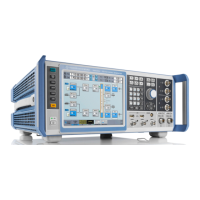Trying Out the Instrument
R&S
®
SMW200A
54Getting Started 1412.9220.02 ─ 21
Signal", on page 51 by the configuration of the required trigger signal and con-
nector settings.
In this example, we use the global USER connectors. Alternatively, you can
achieve the same configuration goal with the local T/M/C connectors.
This test setup requires one signal analyzer, like the R&S
®
FSW, as additional
equipment.
To start the signal generation in Baseband A synchronous to an external
global trigger signal
The configuration requires three main steps with the following goals:
1. Observe the current connector configuration and define an input connector for
the external global trigger signal.
See "To verify the current connector configuration" on page 54
2. Configure Baseband A to use this external global trigger signal as trigger
source.
See "To reconfigure the trigger settings" on page 57
3. Connect the instrument and the external trigger source.
See "To connect the instrument and the external trigger source" on page 58
To verify the current connector configuration
The R&S SMW is equipped with multi-purpose bi-directional local T/M/C connec-
tors and global USER connectors. Because the signal direction, input or output,
and the signal mapping are configurable, we recommend that you check the cur-
rent configuration before cabling or further instrument's configurations.
1. To display an overview of the current mapping of the logical signals to the con-
nectors, perform one of the following:
● In the block diagram, select the Trigger/Marker/Clock status LEDs on the
left side of the "Baseband" block.
● Select "Baseband > Trigger Marker Clock".
Triggering the Instrument with an External Signal

